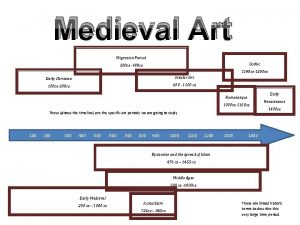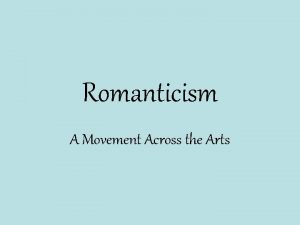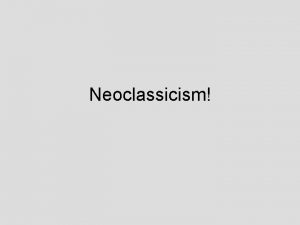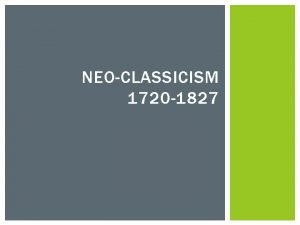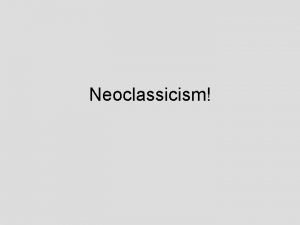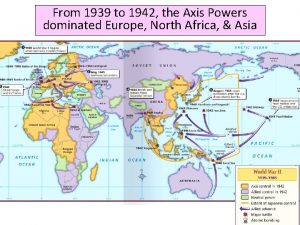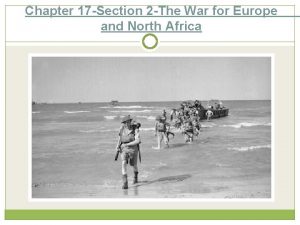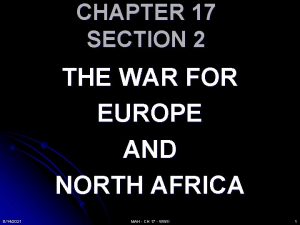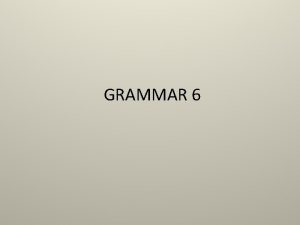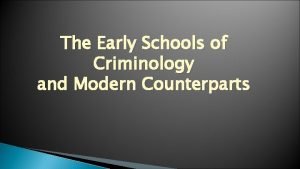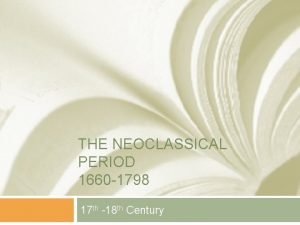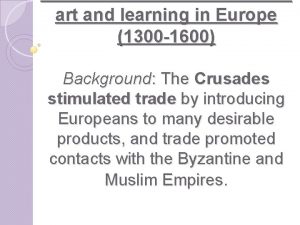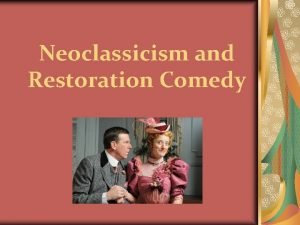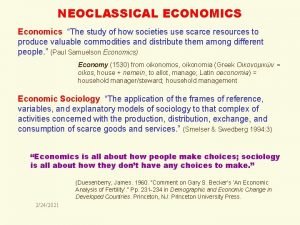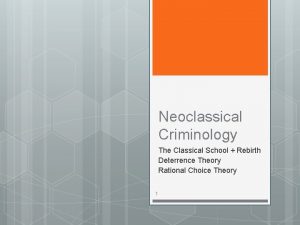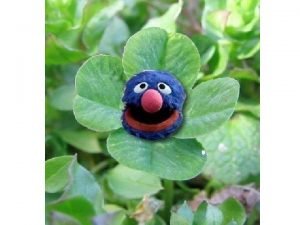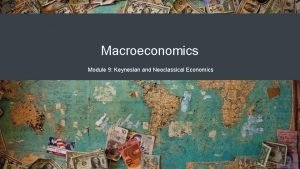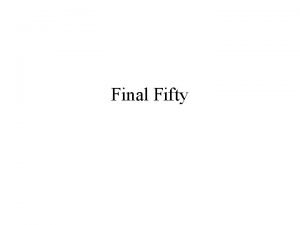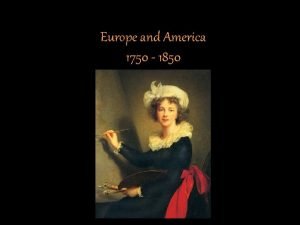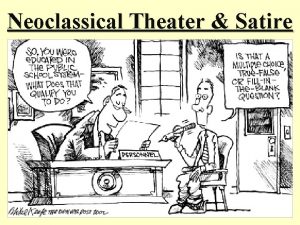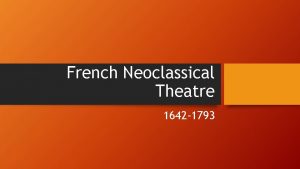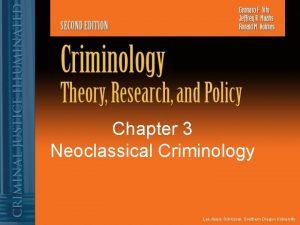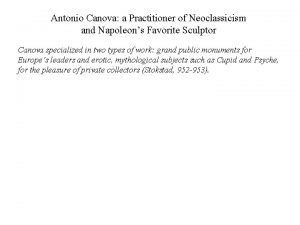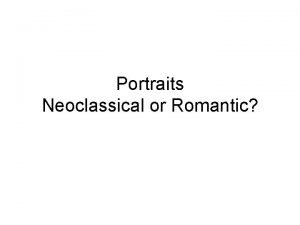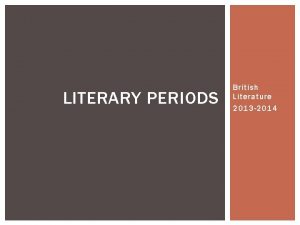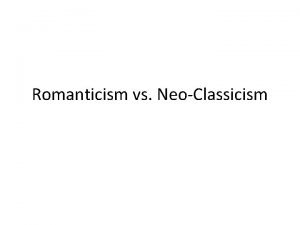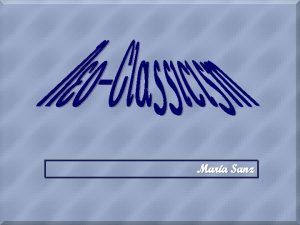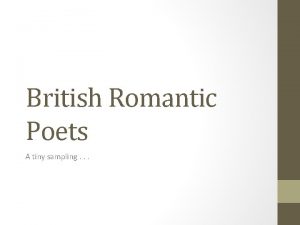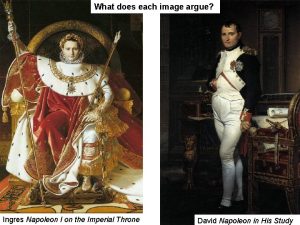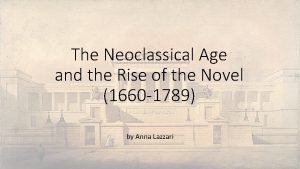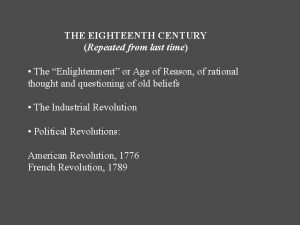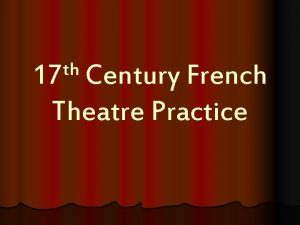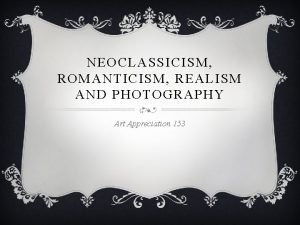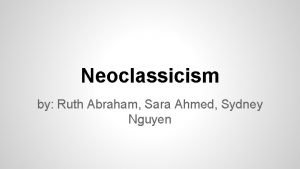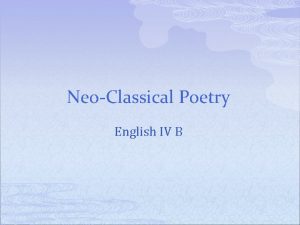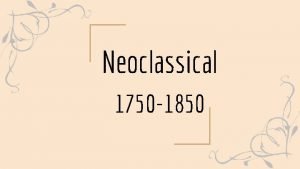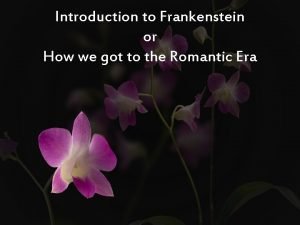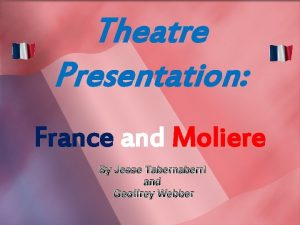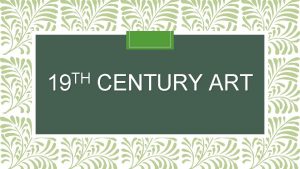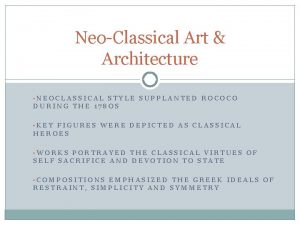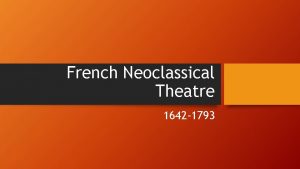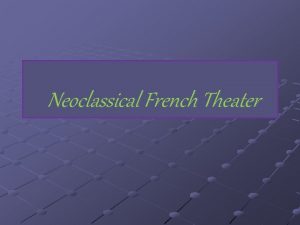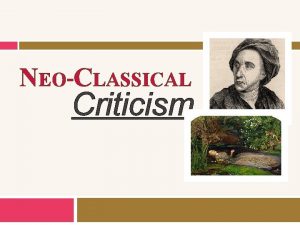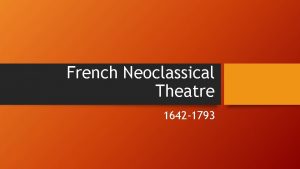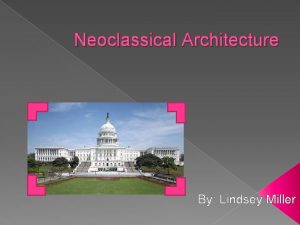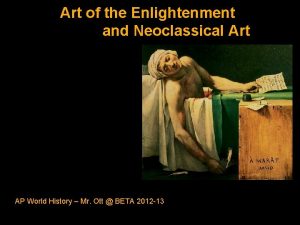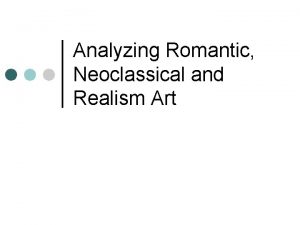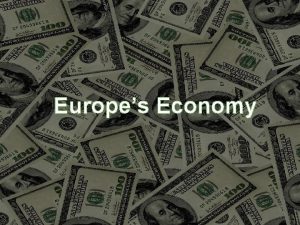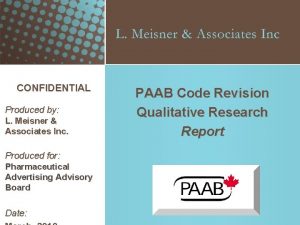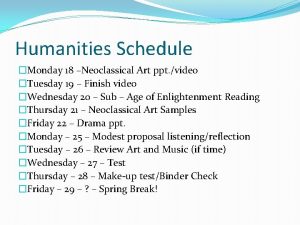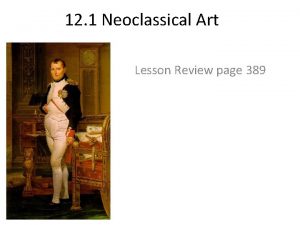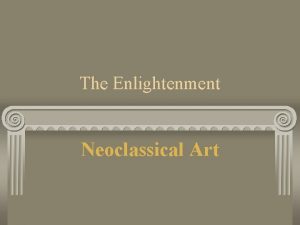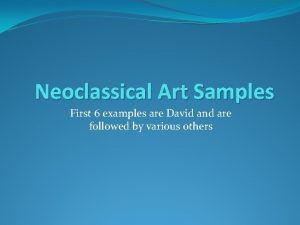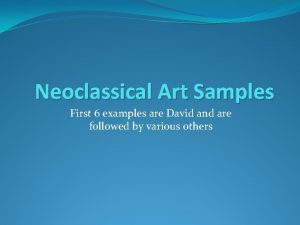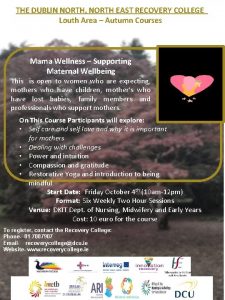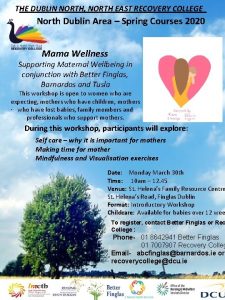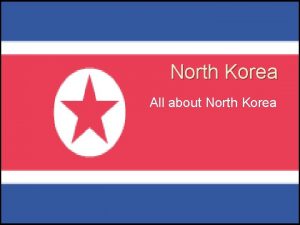NeoClassical Art Art produced in Europe and North














































- Slides: 46


Neo-Classical Art $ Art produced in Europe and North America from 1759 -1815 $ More than just an antique revival not a passing fad. It was a reaction against the surviving Baroque &Rococco style & became a way of life in revolutionary times $ Linked to contemporary political events: S Revolutions established republics in the USA & France. [Neo-Classicism was adapted as the official art style]. S Association with the democracy of Greece & the republicanism of Rome. S Napoleon used the style for propaganda to emulate the Roman emperors


Excavations of the Ruins of Italian Cities • Excavations were uncovered & artifacts came to France interest in Classical themes Pompeii in 1748. Herculaneum in 1738.

Arrival of the Elgin Marbles Thomas Bruce, 7 th Lord of Elgin British Museum, 1806 From the top façade of the Parthenon in Athens.

Characteristics of Neo-Classicism $ Return to the perceived “purity” of the arts of Rome. Style stressed simplicity & order $ Rules of composition & design based on study of Greek, Roman & Renaissance art $ A conviction that there is a permanent, universal way things are (and should be), which obviously entails fundamental political and ethical commitments. $ Art collections of the nobility became nationalized & belonged to the people. Palaces (eg. Louvre) became museums


Characteristics: $ Went back in history to Ancient Greece & Rome to find examples $ Classical simplicity & balance $ Straight lines replaced curves & frills

The Royal Crescent (Circus), 1754 Bath, England John Wood

Brandenburg Gate, 1789 -1794, Karl Langhans $ Topped with a 4 -horse Roman chariot $ Stood as the symbol between East & West Germany

Arc de Triomphe de l’Etoile, 1806 -1836 J. F. Chalgrin $ Napoleon’s official architects. $ They remade Paris in the intimidating opulence of Roman imperial architectural style.

The Church of the Madeleine, 1806 -1843, By Pierre Vignon $ Designed as a Roman Corinthian temple $ Best example in Paris of Neo-Classical architecture

The “Federal Style” in America $ Thomas Jefferson’s influence. Monticello, Virginia University of Virginia U. S. Capitol


Characteristics: $ Studied classical works, often studied in Rome $ Rigid rules and methods $ Art became a study, not just a personal expression

Jacques-Louis David, 1748 -1825 $ 1775 -studied in Rome $ Began painting under Louis XVI, but switched allegiances $ Dominated art-clothing furniture, uniforms, & painting $ Style was clean, crisp could not tolerate brush strokes $ Most important artist under Napoleon

The Oath of the Horatii, 1784 A depiction of dutiful patriotism.

The Death of Socrates, 1787 The death of Socrates was a symbol of republican virtue.

The Death of. Marat, 1793,

Portrait of Madame de Verninac, 1798

Napoleon , 1798

The Intervention of the Sabine Women, 1799

Napoleon at St. Bernard Pass, 1801

Pope Pius. VII, 1805 ,

The Coronation of Napoleon, 1806

Napoleon in his Study, 1812,

The Anger of Achilles, 1825

Jean-Auguste-Dominique Ingres, 17801867 $ A child prodigy, started art school at age 7 & studied under David at 17 -> David’s best pupil $ Lived in Rome for 18 years and returned to Paris & became a defender of Neo-classicism $ Never allowed brush work to show, but was softer and more sensitive to texture $ considered himself a historical painter, but most income came from portraits

Bonaparte as First Consul, 1804

Napoleon 1 on his Imperial Throne, 1806

Romulus—Victory over Acron, 1812 Painted for Napoleon’s palace in Rome.

Le Grande Odalisque, 1814

The Apotheosis of Homer, 1827 This assembly of great artists and writers of all ages gathered to honour the ancient Greek poet before a classical temple.

Elizabeth Vigee-Lebrun, 1755 -1842, $ Successful female painter $ 24 years old-called to Versailles to paint Marie-Antoinette $ 1783 -Elected into the Royal Academy $ Revolution broke out-fled to Italy, Vienna, Berlin, etc $ Softer colours

Marie-Antoinette, 1783

Self-Portrait, 1790 (in Florence)

Terese, Countess Kinsky. 1793


Characteristics: $ Dominate in England $ Writers had to support themselves focus $ Used satire $ Influence from Classical period Virgil & Horace $ Writers applied classical standards to poetry $ later moved to blank verse or unrhymed iambic pentameter

Alexander Pope, 1688 -1744 $ Continues the Augustan Age $ Translated Homer $ Essay on Man (1732 -1734) -an attempt to justify the ways of God to Man, and that man is not himself the centre of all things. -know then thyself, presume not God to scan/the proper study of mankind is man.


Characteristics: $ @ 1750 -a new style of music evolved which employed many themes $ Musicians played for the rich in Europe $ Classical music reflected themes of classicism: order, harmony, stability & symmetry $ Piano replaced the harpsichord

Franz Joseph Haydn, 1732 -1809 $ Wrote over 100 symphonies, 68 string quartets & 20 operas $ Known as the Father of the Symphony $ Friend of Mozart & teacher of Beethoven http: //www. youtube. com/watch? v=fmh 4 OMql. Aic

Wolfgang Amadeus Mozart, 1756 -1791 $ A musical genius $ Composed over 626 works, symphonies, piano sonata, chamber music $ Operas included: The Marriage of Figaro, Don Giovanni, the Magic Flute $ Died young and neglected, either begging for money or writing his Requiem $ The Highest musical achievement of the Classical period


 Migration period art
Migration period art Romanticism vs neoclassicism
Romanticism vs neoclassicism Characteristics neoclassical
Characteristics neoclassical Neoclassic
Neoclassic Neoclassicism characteristics
Neoclassicism characteristics Who dominated europe, north africa and asia from 1939-1942?
Who dominated europe, north africa and asia from 1939-1942? Chapter 17 section 2 the war for europe and north africa
Chapter 17 section 2 the war for europe and north africa The war for europe and north africa chapter 17 section 2
The war for europe and north africa chapter 17 section 2 Integrated care system north east
Integrated care system north east Chapter 14 lesson 1 the industrial north
Chapter 14 lesson 1 the industrial north North america south america asia europe africa
North america south america asia europe africa True north vs magnetic north
True north vs magnetic north The north pole ____ a latitude of 90 degrees north
The north pole ____ a latitude of 90 degrees north Cavalier and metaphysical poetry
Cavalier and metaphysical poetry Neoclassical organization theory
Neoclassical organization theory Modern school of criminology
Modern school of criminology Neoclassical criminology essay
Neoclassical criminology essay Neoclassical period literature
Neoclassical period literature Neoclassicism vs romanticism
Neoclassicism vs romanticism Rebirth of art and learning
Rebirth of art and learning Neoclassical comedy
Neoclassical comedy Neoclassical economics
Neoclassical economics Neoclassical criminology
Neoclassical criminology Apotheosis of homer artist
Apotheosis of homer artist Neoclassical economics examples
Neoclassical economics examples Composition with red, yellow, blue, and black
Composition with red, yellow, blue, and black Napoleon crossing the alps neoclassical or romantic
Napoleon crossing the alps neoclassical or romantic Neoclassical satire
Neoclassical satire Neoclassical french theatre
Neoclassical french theatre Neoclassical theory of crime
Neoclassical theory of crime Neoclassical growth theory vs. endogenous growth theory
Neoclassical growth theory vs. endogenous growth theory Neoclassicism napoleon
Neoclassicism napoleon Neoclassicism portraits
Neoclassicism portraits Timeline of literary periods
Timeline of literary periods David oath of the horatii
David oath of the horatii Characteristics of neoclassical sculpture
Characteristics of neoclassical sculpture Neoclassical poets
Neoclassical poets Napoléon i
Napoléon i The neoclassical age
The neoclassical age Oath of the horatii neoclassical or romantic
Oath of the horatii neoclassical or romantic Neoclassical theater
Neoclassical theater Neoclassicism photography
Neoclassicism photography Neoclassical definition
Neoclassical definition Neoclassical poetry
Neoclassical poetry The death of marat medium
The death of marat medium Neoclassical vs romanticism
Neoclassical vs romanticism Neoclassical plays
Neoclassical plays
